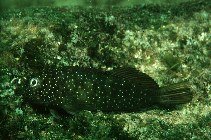| Family: |
Blenniidae (Combtooth blennies), subfamily: Salariinae |
| Max. size: |
10 cm TL (male/unsexed) |
| Environment: |
reef-associated; marine; depth range 0 - 19 m |
| Distribution: |
Indo-Pacific: South Africa to Tanzania, east to Henderson Island, Pitcairn and the Hawaiian Islands; north to China; south to the Great Barrier Reef. |
| Diagnosis: |
Dorsal spines (total): 11-13; Dorsal soft rays (total): 14-16; Anal spines: 2-2; Anal soft rays: 15-17; Vertebrae: 30-32. Diagnosis: Dorsal fin XII, 15, membrane attached to caudal fin, with deep notch above last spine, first spine about equal to twice higher than second; anal fin II, 16; pectoral rays 15; pelvic fin I, 4; caudal fin procurrent rays 10-15. Vertebrae 10 + 21. LL, without scales and scalelike flaps; LL tubes 7-18 (usually 10-18), canal ends below 7th dorsal ray to caudal-fin base. Lower lip crenulated mesially, plicate laterally. Upper lip crenulae 32-46. Gill rakers 18-26. Cephalic sensory pore system complex. Midsnout pores present. Cirri, supraorbital 2-15, nasal 6-16; nuchal 23-36, in 2 groups separated at midpoint of nape, no nuchal flap. Body depth at anal-fin origin 4.3 in SL. Head and body deep and greatly compressed; snout broad and obtuse, convex in profile; eye high and advanced; mouth broad and lower jaw inferior slightly. Geographic variation in color pattern exists; variable body pigmentation - some uniformly brown, other forms with bars or spots, or have colored peduncles, usually yellow or scarlet; black iris with yellow, irregular-shaped inner ring. (Ref. 529, 634, 90102) |
| Biology: |
Found in algal ridge and crests between surge channels of exposed seaward reefs (Ref. 205, 58302). Usually taken in water less than 10 m deep, but has been collected at depths as great as 19 m (Ref. 529). Feeds on benthic algae (Ref. 89972). Benthic (Ref. 58302). Oviparous. Eggs are demersal and adhesive (Ref. 205), and are attached to the substrate via a filamentous, adhesive pad or pedestal (Ref. 94114). Larvae are planktonic, often found in shallow, coastal waters (Ref. 94114). |
| IUCN Red List Status: |
Least Concern (LC); Date assessed: 24 March 2009 Ref. (130435)
|
| Threat to humans: |
harmless |
Source and more info: www.fishbase.org. For personal, classroom, and other internal use only. Not for publication.
